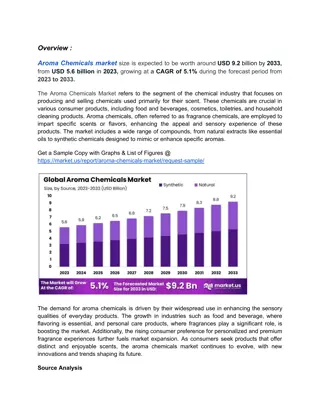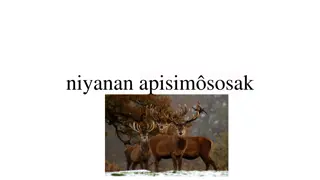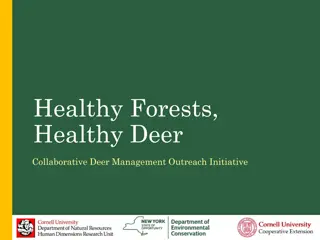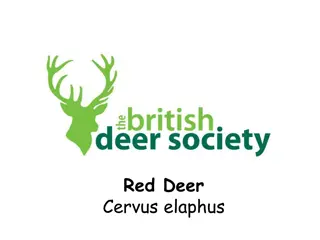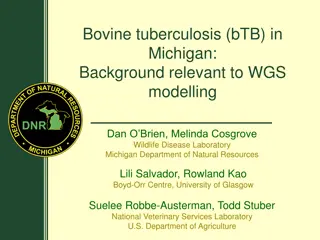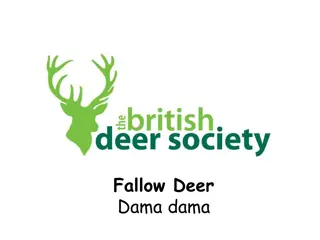
Himalayan Musk Deer: Facts, Behavior, and Conservation Status
Discover interesting facts about the Himalayan Musk Deer, including its habitat, scientific classification, breeding and feeding habits, as well as its current endangered status due to poaching for musk extraction. Learn how these elusive creatures survive in the Himalayan region and what actions are needed to protect them.
Download Presentation

Please find below an Image/Link to download the presentation.
The content on the website is provided AS IS for your information and personal use only. It may not be sold, licensed, or shared on other websites without obtaining consent from the author. If you encounter any issues during the download, it is possible that the publisher has removed the file from their server.
You are allowed to download the files provided on this website for personal or commercial use, subject to the condition that they are used lawfully. All files are the property of their respective owners.
The content on the website is provided AS IS for your information and personal use only. It may not be sold, licensed, or shared on other websites without obtaining consent from the author.
E N D
Presentation Transcript
HIMALAYAN MUSK DEER BY- OISHIKA SANTRA
The white-bellied musk deer or Himalayan musk deer is a musk deer species occurring in the Himalayas of Nepal, Bhutan, India, Pakistan and China. Its scientific name is Moschus leucogaster. It scommonly known as Kasturi mriga in Nepali and Lah in Tibetan language.
SYSTEMATIC POSITION Kingdom: Animalia Phylum: Chordata Class: Mammalia Order: Artiodactyla Family: Moschidae Genus: Moschus Species: leucogaster
in dense cover and are shy and secretive. At night, they emerge to feed in more open habitats, They are sedentary occupying a small home range of up to 22 hectares. Males are fiercely territorial, only allowing females to enter their range. Territories are marked by carefully placed defecation sites and strong- smelling secretions, which are placed onto the surrounding plants. Males fight each other over females during the mating season and use their long canines to fight and defend their territories. The females hide from all the commotion. For the males to attract the females and bring them out from hiding, they use their strong smelling musk. Himalayan musk deer can live for up to 10 to 14 years. During the day, white-bellied musk deer hide
BREEDING & FEEDING They are dioecious and seasonal breeders. During the mating season, male Himalayan musk deer become anxious, competitive, and eat little. The females demonstrate exhaustion and attempt to stay in hiding. The male's musk sac is key in attracting females during the mating season; the sac emanates a strong smell meant to lure the females from hiding. Himalayan musk deer are herbivores and feed on what is seasonally available. Accordingly, they eat grasses, forbs, mosses, lichen, twigs, shoots, and plant leaves. They are ruminants, so they can quickly leave feeding grounds if threatened and further digest their food later when safe from harm. Occasionally, Himalayan musk deer travel great distances at night to forage for food. They may travel 3 to 7 km per night, but they always return to their usual territories by daybreak. Himalayan musk deer mate between November and January. The gestation period is 185 to 195 days. One to two young are typically born between May and June and nurse from their mother for about 2 months. During this time, the young remain in hiding, independent of their mothers except when feeding. Primary Diet: herbivore Plant Foods: leaves wood, bark, or stems bryophytes lichens Other Food: Fungus
Current Status Current Status Musk Deer s survival is threatened most seriously by poaching. Musk pod Beside hunting for meat which is considered as a delicacy locally, hunting of Musk Deer is primarily due to the commercial demand of musk which is used in manufacture of perfume, medicine and cosmetics. Red list Category and criteria: Endangered Musk Deer killed by poachers





